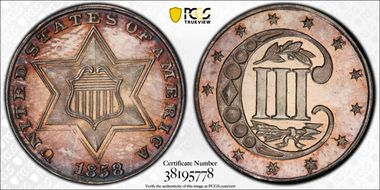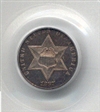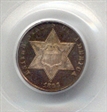SCARSDALE 的钱币相册
CAC 1851 3CS MS67 PCGS. CAC. An impressive first-year type coin, sharply struck from unlapped dies. Each side glows with creamy-white satin luster, devoid of bothersome abrasions. Among the finest pieces certified, and a rarity in this grade with CAC endorsement. Population: 32 in 67 (5 in 67+), 0 finer. CAC: 11 in 67, 0 finer (4/21).
CAC Currently the PCGS Pop report shows 8 certified 1851-O in MS66, however this is not truly correct as this example had been submitted 4 times in hope of reaching 67 status….by todays current standards the 67 designation would easily be attainable!
CAC Fluorescent blues, greens, and oranges stand out on the surfaces of this very attractive piece
CAC This is a bright and fully original with an excellent strike. It also appears that this coin was struck with slightly rusted dies as there is a pronounced grainy effect in the fields! Ex Gil Clark Type Collection.
CAC This is a bright and fully original with an excellent strike. It also appears that this coin was struck with slightly rusted dies as there is a pronounced grainy effect in the fields! Ex Gil Clark Type Collection.
CAC This is a bright and fully original with an excellent strike. It also appears that this coin was struck with slightly rusted dies as there is a pronounced grainy effect in the fields! Ex Gil Clark Type Collection.
CAC 1853 Three Cent Silver, MS67 One of the Finest Certified Survivors 1853 3CS MS67 PCGS Secure. CAC. This original Type One Superb Gem is essentially unmarked and displays a bold strike on the design features. Mottled blue and russet patina adheres mainly to the peripheral areas. Faint clash marks from the shield are apparent within the bars of the denomination. Among the finest survivors from this early issue in the series. Population: 14 in 67 (3 in 67+), 0 finer. CAC: 12 in 67, 0 finer (6/18).(Registry values: N2998) Coin Index Numbers: (NGC ID# 22Z2, PCGS# 3667, Greysheet# 3620)
CAC First year of the Type Two design and one of the most challenging issues in the series, especially in Gem condition. This piece has a remarkably strong strike for the type (except, of course, on the reverse stars), and the mint luster is full and frosted. Each side has pale ice-blue patina with an irregular overlay of golden/brown patina. A couple of horizontal die cracks are seen on the obverse and there is just the slightest evidence of the clashing in the fileds (normally a very pronounced feature on three cent silver pieces.) Pedigree From the Robert Bowling Collection
CAC This is one of the finest examples known of this scarce date! Amazing luster resides in the fields, which shines through rich toning flecks that inhabit the obverse, and flashes with shimmering reflectivity through the green, blue, and crimson hues. The reverse is more uniformly toned with deep greenish-gold shades, but again the dazzling luster is apparent. Only 139,000 pieces were struck for this scarce date, and not many exist that can even approach this stellar example. The strike is reasonably sharp but for a hint of softness on the periphery, and both dies show the commonly seen die clashing. PCGS 8, NGC 5, CAC 5.
CAC An attractive blend of turquoise and rose-gray toning cloaks each side of this thoroughly original gem while boldly detailed over the major devices, noticeable weakness is found about the stars and lettering, a common mala design
CAC This is a stunning example of a terribly undervalued coin. Exquisite surfaces are flawless. Even using a strong glass there is nothing to find. The luster is moderate due to the heavy toning. Both sides have a wonderful deep but totally original mix of navy/magenta/golden brown colors. Every detail is actually needle sharp in strike. The eye appeal is pretty neat! PCGS 3, NGC 5, CAC 3. PCGS has possibly graded 3 higher. The last auction appearance of one of these was back in July 2015. That coin brought $15,275. Today the PCGS CAC price guide shows $14,400. We can tell you, you will never have many opportunities to buy a higher grade 1856 MS 3CS. Good luck! Cert. Number 84018495 PCGS # 3672.00
CAC Golden hues on the obverse make this little trime very attractive, a very pq original example!
From an old time collection we purchased this coin with high hopes...it has the look of MS...such original gold "stain" toning! yet, we are still happy to receive the AU58 and place it into the Working Mans Set
An attractive uncirculated example of a 1860 Three Cent Silver piece, with excellent eye-appeal for the grade. The obverse is splashed in violet and blue iridescence while the balance of this satiny example exhibits only traces of russet peripheral toning
CAC - Essentially superb in every respect. A rich, glowing satin luster radiates all over, accenting orange, gold, green, lilac, and soft silver-pewter surfaces. Sharply struck up from clashed dies, this wonderful coin is very high end and very pleasing. Pedigree Seattle Collection which was assembled by a dedicated collector over the course of the last two decades,
Too think that we offered this coin for sale back in 2009 for only $115.... now with a Gold sticker its worth considerably more!
Nice, Original, Variety, that has a very strong repunched date along with being an overdate!
CAC 1862/1 3CS MS66 PCGS. The underdigit on this piece is a bit fainter than usually seen, most likely because of the vigorous die polishing seen in the fields on each side. Brilliant throughout, the fields shimmer with semi-prooflikeness and there are no reportable abrasions on either side. A terrific type coin with immense eye appeal.
CAC FROM THE IPSWICH COLLECTION. This coin borders sheer perfection. Proof like mirrors do beam vividly from all over. The mirrors are clean, smooth, and offer a strong reflection. Both sides are evenly covered by an original and moderate to deeper mix of purple/magenta/evergreen/olive/navy colors. Every detail is sharply struck and has thick frost. If this coin were just slight lighter in color, we could see it grade as high as MS67! The eye appeal is just fine. PCGS 22, NGC 13, CAC 8. The last PCGS CAC piece to sell brought $7,050 in August 2017. We assure you, this piece will please the pickiest! Cert. Number 34347911 PCGS # 3682
Gold CAC Sharply struck gem of the highest order, somewhat prooflike in appearance, richly toned. Obverse shield is deep iridescent gold, surrounding fields display iridescent violet and sea green. The reverse displays deep iridescent blue at the center that spreads outwards through shades of rose and gold
CAC Rich, golden russet with touches of green and blue! Dazzling Mint Frost!!!
CAC ELIASBERG PEDIGREE - One of the few business strikes produced and much rarer than the proofs of this date. This is simply a gorgeous coin. The fields are brightly lustrous, very interesting and prominent die clashing evident on both sides, One of the finest business strikes known of this rare issue and a superlative example.
Gold CAC Awesome blues and reds stand out on this gorgeous piece! Only 4,000 minted. Pedigree William Wasler Collection
CAC OGH An exceptional piece with fairly even, moderate toning with great luster showing through. Housed in a old PCGS green holder!
1869/'8' 3CS MS67+ PCGS. CAC. Pedigree Ex: Simpson. The 1869-dated three cent silver pieces from these dies are traditionally called overdates. However, some observers have questioned the true nature of the variety, suggesting that it is either a recut 1869/9, or the result of a die line inside the digit. According to PCGS Coin Facts, this is the only Mint State example that is identified as the "overdate" variety, while 11 proof examples carry the same identification. Regardless of its name, the fact is that this is the second finest PCGS-certified Mint State 1869 three cent piece of any variety. A sharply struck Superb Gem, this piece has brilliant satin luster beneath blue central toning with a ring of gold and iridescent toning, nicely matched on each side. Population: 1 in 67 (1 in 67+), 0 finer. CAC: 1 in 67, 0 finer (1/21).
A spectacular prooflike Gem example. Sharply struck and vividly toned, especially on the reverse, in electric hues of gold, blue, and pink. A desirable low-mintage issue. A mere 4,360 trimes were minted in 1871, with proofs accounting for 960 pieces. Today, Gem business strikes are much scarcer than proofs and sell for substantially higher premiums in corresponding grades of preservation.
The sale of proof coins to the general public did not begin until 1858. While proof Trimes exist in most years prior to 1858, their mintage was miniscule. Although the proof mintage for 1858 Three Cent Silvers is unknown, it was decidedly very low. Surprisingly, two varieties are known, one with a repunched 5 in the date, and the second with die lines (as minted) above TED in UNITED. This rare and untoned representative is from the second variety. It has a strike that is complete except for the details of a couple of the reverse stars. The mirrored fields lack contrast with the devices, but have good reflectivity. A few hairlines on both sides do not interfere with the appeal of this desirable, rare proof specimen.
Probably the finest 1856 you''ll ever see, this little gem came from an 1856 proof set! Hows that for a pedigree!
Very PQ for the grade, with lovely iridescent toning; features light purple, blue, and sunset colors!
Reflective fields and frosted motifs show rich gold and violet iridescence, especially so at the rims. Sharp and appealing, a near-pristine gem of a high order. PCGS has not certified a Proof example of the date at a finer grade, making the present specimen even more appealing!
1802/1 $5 BD-2, High R.4, VG10 PCGS. CAC. Bass-Dannreuther Die State c/c with a cud over the F in OF. Rich peach-gold toning deepens near the borders of this circulated Heraldic Eagle five. The wings and portrait exhibit substantial wear, but the date and other peripheral legends are bold, and there are no mentionable marks. Presently the only VG10 1802/1 half eagle with a CAC seal (1/18).
Breen-6459, B. 1-A, Miller-109, R.2. A canary-gold piece extensive bright luster and scant evidence of highpoint friction. A faint vertical pinscratch is in the left obverse field, otherwise an undisturbed and attractive example. Well struck aside from the rightmost portion of the horizontal shield lines. Along with the 1807, the 1810 Large Date, Large 5 is the most available variety of this desirable type and is often the candidate chosen for gold type sets.
1812 $5 MS 62 PCGS. Wide 5D. Ex: Bass Collection. B. 1-B. Miller-118, R.3. Sold as lot 801 in the second offering of Bass coins, where it was described as, "Sharply struck with very attractive light orange-gold lustre. Minor surface marks do not distract from the aesthetic appeal. Heavy obverse and reverse clash marks. No die cracks are noted." Ex: Bass II (Bowers and Merena, 10/99), lot 801, where it realized $8,912.50; purchased by Bass from A-Mark Coin Co., March 16, 1978.
1813 $5 BD-1, R.2, MS62 PCGS. CAC. Ex: King Farouk. Bass-Dannreuther Die State a/a. The 1813 is the first issue of the Capped Bust Left type, which, as a whole, was subject to extensive hoarding and melting as gold was driven out of circulation. This date was saved to a much greater extent than later issues, with 450 to 650 survivors of the BD-1 die pair alone. BD-1 representatives are distinguished from their BD-2 counterparts by the placement of the first S in STATES over the right side of the E on the ribbon below. The present example was sold as part of the King Farouk holdings in 1954. Maurice Storck attended that famous sale and likely purchased the coin either directly at auction or soon after from one of the other dealers in attendance. Orange accents appear over lustrous yellow-gold surfaces that show only minor disturbances in the fields. The overall impression is bold with minor roller marks on the portrait and lower obverse border. Eye appeal is tremendous. A perfect type coin with a great provenance. Ex: King Farouk; Palace Collections of Egypt (Sotheby's, 2/1954), lot 233. From The Maurice Storck Collection.
1813 $5 BD-1, R.2, MS62 PCGS. CAC. Ex: King Farouk. Bass-Dannreuther Die State a/a. The 1813 is the first issue of the Capped Bust Left type, which, as a whole, was subject to extensive hoarding and melting as gold was driven out of circulation. This date was saved to a much greater extent than later issues, with 450 to 650 survivors of the BD-1 die pair alone. BD-1 representatives are distinguished from their BD-2 counterparts by the placement of the first S in STATES over the right side of the E on the ribbon below. The present example was sold as part of the King Farouk holdings in 1954. Maurice Storck attended that famous sale and likely purchased the coin either directly at auction or soon after from one of the other dealers in attendance. Orange accents appear over lustrous yellow-gold surfaces that show only minor disturbances in the fields. The overall impression is bold with minor roller marks on the portrait and lower obverse border. Eye appeal is tremendous. A perfect type coin with a great provenance. Ex: King Farouk; Palace Collections of Egypt (Sotheby's, 2/1954), lot 233. From The Maurice Storck Collection.
B. 1-A, Miller-121, the only known dies, High R.5. Produced to the extant of only 15,454 pieces, the 1814/3 is a difficult issue to locate in today''s market. Extant representatives are scarcer than their 1813 and 1818 counterparts and the encountered grade is likely to be in the VF or XF range.
The 1827 half eagle is a well-known melt rarity with an estimated three dozen known from a mintage which is estimated to be 24,913 coins. This issue saw little circulation, and the majority of the survivors are Uncirculated, including a few Gems. It is difficult to imagine a more aesthetically appealing example for the grade, with both the obverse and the reverse showing very deep natural orange-gold colors which flash reddish-gold hues when the coin is tilted towards a light source. There is no real wear seen on either side and this coin has what used to be referred to as “cabinet friction” on the high spots. One very thin scratch in the left obverse field is barely noticeable with the naked eye, and this is an exceptionally attractive coin.
The 1827 half eagle is a well-known melt rarity with an estimated three dozen known from a mintage which is estimated to be 24,913 coins. This issue saw little circulation, and the majority of the survivors are Uncirculated, including a few Gems. It is difficult to imagine a more aesthetically appealing example for the grade, with both the obverse and the reverse showing very deep natural orange-gold colors which flash reddish-gold hues when the coin is tilted towards a light source. There is no real wear seen on either side and this coin has what used to be referred to as “cabinet friction” on the high spots. One very thin scratch in the left obverse field is barely noticeable with the naked eye, and this is an exceptionally attractive coin.
Breen-6509, Second Head, Large Date McCloskey 4-C, R.3. The reverse is surprisingly well struck, while the obverse has only a hint of softness of definition on the left side stars. The portrait has just a trace of friction, and the olive-gold surfaces have considerable satiny luster.
CAC Beautifully toned in iridescent reddish-gold, this beautiful example also sports sharp striking detail and billowy mint luster. Until Mid 2018 this was the finest FS-302 graded by PCGS, a repunched date variety where the engraver initially punched the date too low, then punched the logotype in the correct position. The misplaced digits can be seen quite boldly with a glass. Just a few trivial frost breaks/very light scuffs can be seen with a strong glass only. All of the details are sharply struck. The eye appeal is fantastic! Pedigree Ipswich Collection
Having owned ever example of this including the original discovery coin, this is the finest known... The holy grail of varieties
Having owned ever example of this including the original discovery coin, this is the finest known... The holy grail of varieties
1854 3CS Repunched Date, FS-301, MS65 PCGS. The date was initially entered too far west, then repunched in the proper position. A curve left of the knob of the 5 is the clearest remnant of the initial date logotype entry. This attractive Gem exhibits well-detailed design elements, with a touch of softness on some star centers and some interesting clash marks on both sides. The well-preserved lustrous surfaces display hints of gold and amber toning.
1854 3CS Repunched Date, FS-301, MS65 PCGS. The date was initially entered too far west, then repunched in the proper position. A curve left of the knob of the 5 is the clearest remnant of the initial date logotype entry. This attractive Gem exhibits well-detailed design elements, with a touch of softness on some star centers and some interesting clash marks on both sides. The well-preserved lustrous surfaces display hints of gold and amber toning.
Very difficult to locate so choice (the pops are incorrect for this date) Sleek, silvery, and boldly reflective mirrors burst from both sides. All of the details are sharply struck and have thick frost. The eye appeal is pretty and flashy!
An incredible cameo coin that traces back to the owner of a small coin shop that had stuck it away many decades ago!
A very flashy, glassy mirrored Gem proof, this piece displays deep cobalt-blue toning over most of each side with lighter, occasional accents of golden and rose color. A very impressive proof whose depth of toning does not obscure the underlying brightness of the proof mirrors.
This is an absolutely gorgeous Trime with glittering fields and well frosted devices. Bold contrast is evident beneath warm crimson-champagne iridescence. Only 4,360 Three Cent Silvers were produced in 1871, 960 pieces of which were proofs. To date, this is only the second proof 1871 certified as Cameo by PCGS, the other grading only PR64
1872 3CS PR66 Cameo PCGS. Using a single set of dies, the Philadelphia Mint delivered 1,000 business strike and 950 proof Three Cent Silvers in 1872. Since representatives of the first group do not turn up with any degree of regularity, extant specimen strikings are prized among date collectors. Whereas some proof 1872 Trimes in today's market are impaired, the present Gem is free of bothersome post-production impairments. Glassy in the fields, both sides are also suitably well frosted over the devices. A few small planchet flaws and strike throughs (both as struck) are noted.
This richly toned, mostly golden-russet example reveals deep reflectivity as the coin turns into the light. Certain angles also allow appreciation of the deeply frosted devices yielding the pronounced cameo effect of often coveted by collectors. Fully struck and free of distracting hairlines!
1795 $5 Small Eagle, BD-10, R.5, AU58 PCGS. Ex: Harry W. Bass, Jr. Collection. Bass-Dannreuther Die State c/b. This is the BD-10 plate coin in the Bass-Dannreuther reference. While the BD-10 variety is reasonably available from an estimated 40 to 50 surviving examples, few of those can match the quality of this near-Mint coin. The BD-10 die pair shares its obverse with the BD-8 and BD-9 varieties, easily identified by its crowded date numerals squeezed into the small space between Liberty's lowest curl and down-sloping drapery. Obverse die lapping removes die clashing visible on BD-9, and the obverse stars appear somewhat smaller than usual as a result. Four berries decorate the reverse wreath -- two left and two right, distinguished by the inside-right berry lower than any other Small Eagle reverse. Brilliant yellow-gold surfaces are lightly abraded with a hint of high-point wear from brief circulation. There are no heavy marks, although the lower-right reverse rim shows Mint-made adjustment marks that eliminate the dentils in that area. Considerable prooflike flash remains within the outer legends. Both the D in UNITED and the second T in STATES are markedly recut and serve as interesting diagnostics, not mentioned in the Harry Bass commentary or the Dannreuther text. The finest BD-10 Small Eagle five dollar gold piece appeared in our April 2015 Central States Platinum Night auction, an amazing MS64 Prooflike coin certified by NGC. While that coin remains head and shoulders above the two Mint State coins, the present Harry Bass Core Collection coin claims a leading role among near-Mint examples and is notably impressive in its own right. Early half eagle enthusiasts are sure to take note.























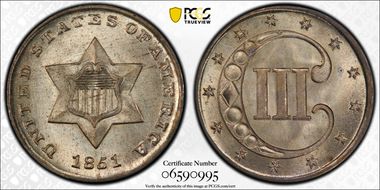

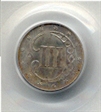





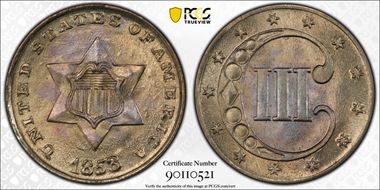


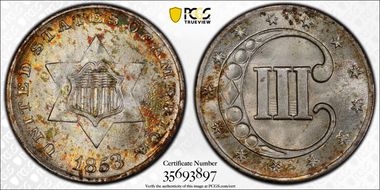




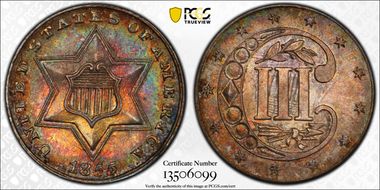



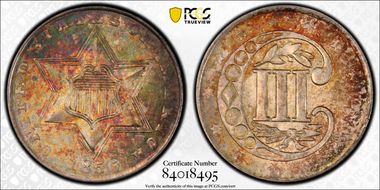











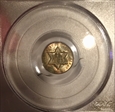




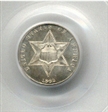

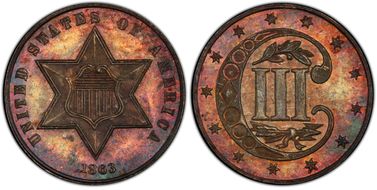

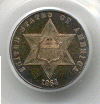



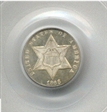
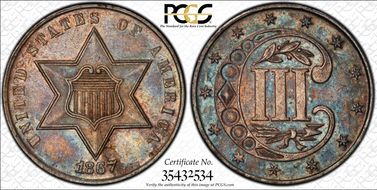


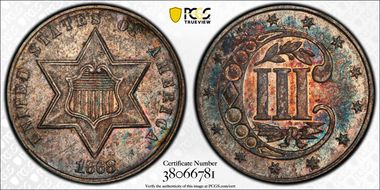




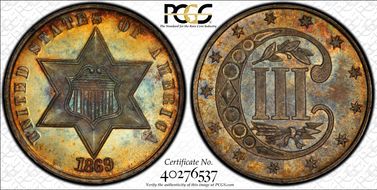

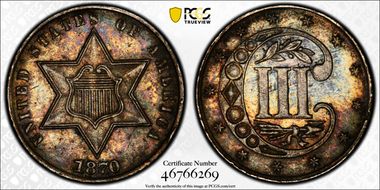









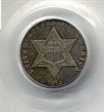

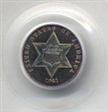



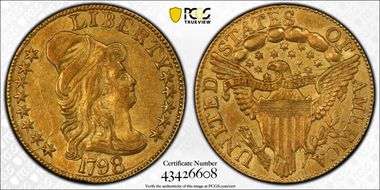



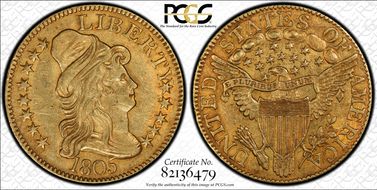


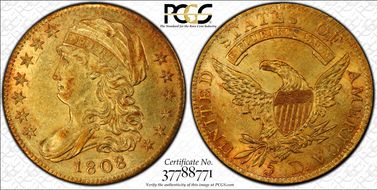

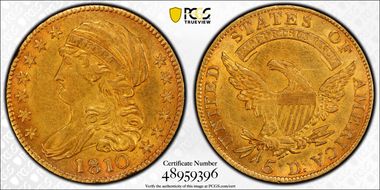



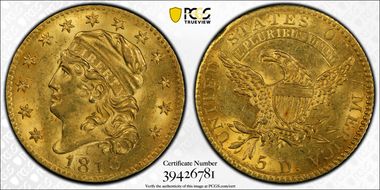



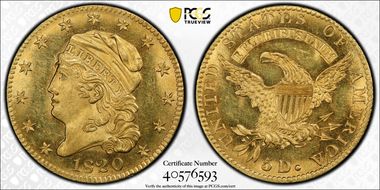






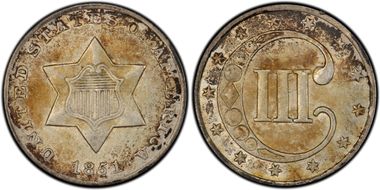

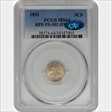







_album.jpg)
_album.jpg)
